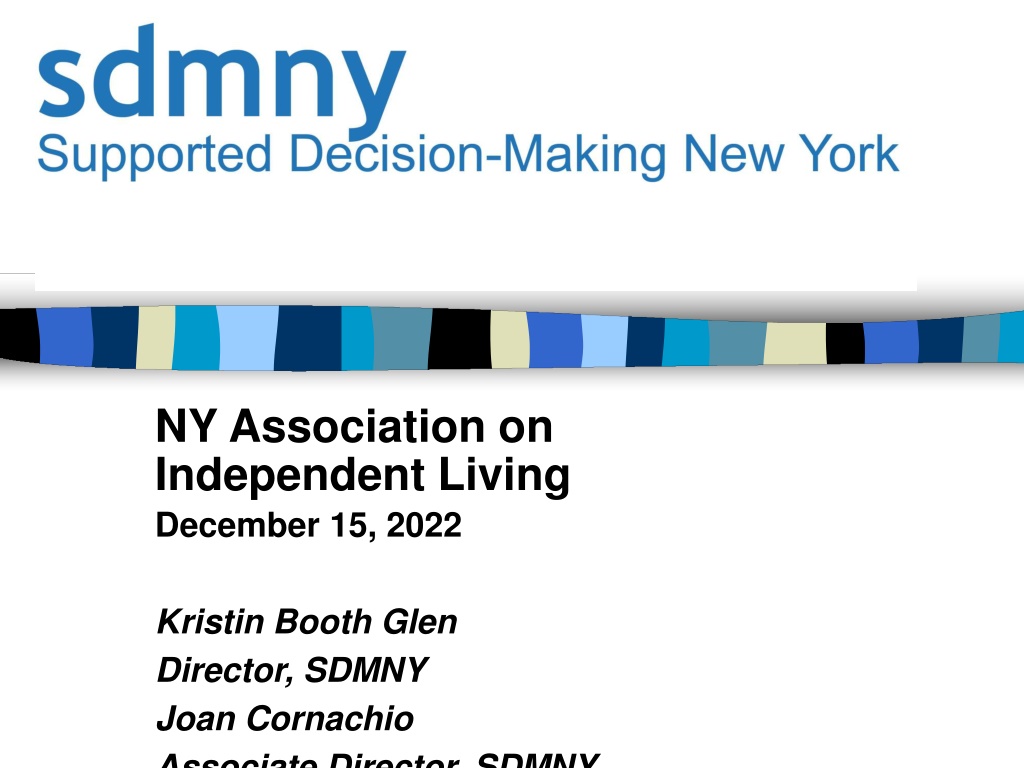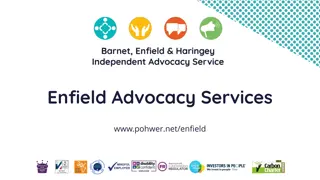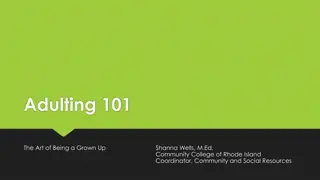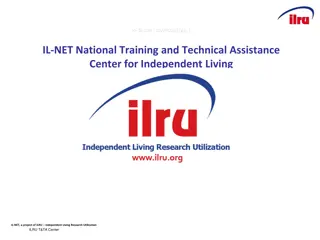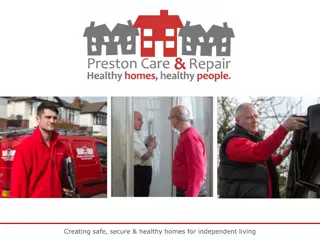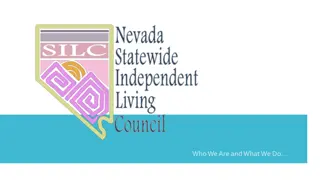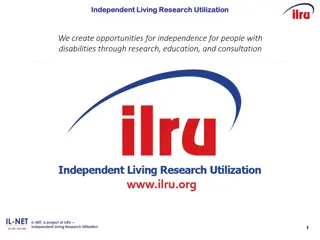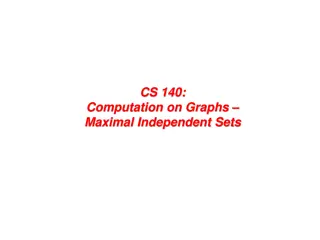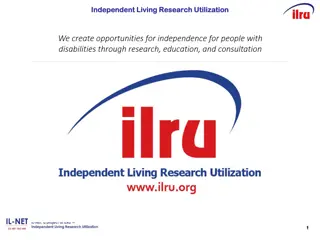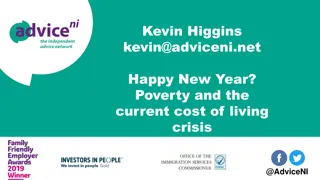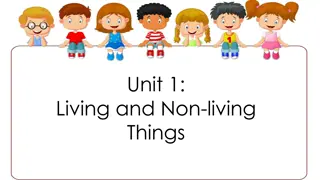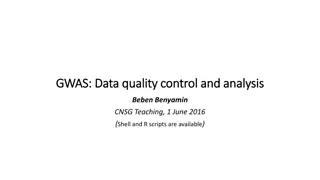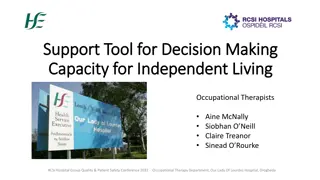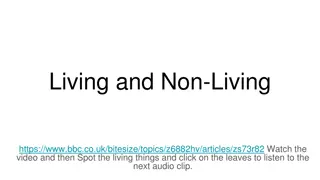NY Association on Independent Living
Supported Decision-Making (SDM) empowers individuals with disabilities to make their own choices with assistance, offering an alternative to guardianship. The SDMNY initiative, funded by various organizations, aims to educate stakeholders, develop SDM processes, restore rights, and create sustainable practices. Results show widespread recognition of SDM's effectiveness, leading to legislative developments and future implementation plans. ILCs play a crucial role in understanding and implementing SDM practices to support individuals in leading self-determined lives.
Download Presentation

Please find below an Image/Link to download the presentation.
The content on the website is provided AS IS for your information and personal use only. It may not be sold, licensed, or shared on other websites without obtaining consent from the author.If you encounter any issues during the download, it is possible that the publisher has removed the file from their server.
You are allowed to download the files provided on this website for personal or commercial use, subject to the condition that they are used lawfully. All files are the property of their respective owners.
The content on the website is provided AS IS for your information and personal use only. It may not be sold, licensed, or shared on other websites without obtaining consent from the author.
E N D
Presentation Transcript
NY Association on Independent Living December 15, 2022 Kristin Booth Glen Director, SDMNY Joan Cornachio Associate Director, SDMNY
Who Are We? From 2016-March 31, 2021,a consortium of Hunter/CUNY, NY Alliance for Inclusion and Innovation; Arc Westchester; Disability Rights New York (DRNY) Funded by NYS Developmental Disabilities Planning Council (DDPC) as 5-year pilot project (largest in the US, second largest in the world!) From 2021-2022,funded for a final bridge year by the Ford Foundation, the FAR Fund, and the Taft Foundation
The goals of the DDPC grant Educate stakeholders about the emerging practice of supported decision-making (SDM) Develop and pilot a process by which people with I/DD can avoid guardianship or, if already subject to guardianship, have their rights restored Develop an evidentiary base for Supported Decision-Making Agreement (SDMA) legislation Create plan for sustainability
Results of the pilot SDM now widely recognized, including by the courts, AAIDD, ARC US (and NY), National Council on Disability (NCD), American Bar Association, Administration for Community Living (ACL), Social Security Administration, National Guardianship Association, etc. as a less restrictive alternative to guardianship SDM facilitation process piloted, refined, evaluated, with almost 100 Decision-Makers with SDMAs and many more in the pipeline 2021-22: OPWDD introduces SDMA legislation based on SDMNY Principles : signed 7/26/22 SDMNY plan for sustainability incorporated into OPWDD grant
2022: OPWDD Implementation grant SDMNY funded for 3 years to design and pilot a facilitation service delivery system that could be scaled up to serve everyone in NY who wants SDM facilitation
What ILCs need to know What is Supported Decision-Making? What is the SDMNY facilitation process? What does the new SDMA legislation do? What are the implications/opportunities for ILCs?
What Is Supported Decision-Making? Supported decision-making (SDM) is a series of relationships, practices, arrangements and agreements of more or less formality and intensity designed to assist an individual with a disability to make and communicate to others decisions about the individual s life. Robert Dinerstein (2012)
Supported Decision-Making Can Take Many Forms Completely informal (so it is often invisible) Informal but with an oral or written Supported Decision- Making Agreement (SDMA) Formalized through a facilitated process that results in a written and signed SDMA (SDMNY model) Legalized by statute, with third parties (health care providers, financial institutions, landlords, etc.) required to accept decision made by persons with SDMAs
Where Does SDM Come From? Our common experience of how everyone makes decisions The human right of every person to make their own decisions regardless of disability
Everyone Uses Supports: Normalization When you make an important decision, how do you do it? Consulting friends and/or family? Using experts (lawyers, accountants, etc.)? Doing and utilizing research? People with I/DD may just need more or different kinds of support
Steps in Decision- Making/Kinds of Support Gathering necessary information Understanding that information Identifying possibilities and alternatives Considering consequences Weighing the choices Communicating the decision to others Implementing the decision
Human Rights:UN Convention on the Rights of Persons with Disabilities (CRPD) Article 12 States Parties reaffirm that persons with disabilities have the right to recognition everywhere as persons before the law. States Parties shall recognize that persons with disabilities enjoy legal capacity on an equal basis with others in all aspects of life. States Parties shall take appropriate measures to provide access by persons with disabilities to the support they may require in exercising their legal capacity. 1. 2. 3.
SDMNY Facilitation The goal: to enable a person with I/DD to make their own decisions with the support of trusted persons in their lives How we do it: a three phase facilitation process in which a trained facilitator, backed by an experienced mentor works with the person with I/DD (the Decision- Maker) and their chosen supporters over an average of 14 meetings, culminating in a signed SDMA
Main components of the facilitation process Unpacking how decisions are made; identifying the seven steps; mapping decisions that the Decision-Maker is and may be engaged in Facilitating the Decision-Maker in identifying the domains in which they want support, the kinds of support they want, and the persons from whom they want to receive that support Fostering intrinsic motivation through competence, autonomy and relationship Educating supporters on SDM; unpacking and mapping, re-positioning from previous relationships; exploring dignity of risk ; building capacity for long term commitment to support
Phase 1: DM Facilitation Working with the DM and utilizing mapping and the SDMA worksheet to ascertain: how the DM receives information; using mapping to see how decisions are made; the kinds of decisions they currently make and want to make in the future (e.g., health, money, work, education, etc.) who helps them in making decisions and who they would like to support them in the future (e.g., one person per area vs. circle of support) what kinds of support they want to receive (gathering information, communicating decisions, helping weigh alternatives, etc.) how the DM wants to use their Supporter(s) when a decision is to be made
Phase 2: Supporter Facilitation Working with the Decision-Maker s chosen Supporters to educate them about SDM including unpacking and mapping their own decisions Repositioning them from their existing roles (such as parents who currently make decisions for the Decision-Maker) Gaining their commitment to that role, including the dignity of risk and to honoring the primacy of the Decision- Maker in their decision-making
Phase 3: Team Facilitation Working with the Decision-Maker and Supporters Utilizing the SDMA BigFour chart to negotiate the supported decision-making (SDMA) agreement Modeling what that process should look like, with the Decision-Maker at the center From the first draft of the SDMA, incorporating all changes in a final agreement, which all parties understand and to which they give their assent
Product/Results of Facilitation A signed contract the Supported Decision-Making Agreement (SDMA) that sets out the areas in which the Decision-Maker wants support, the kinds of support requested and the persons from whom that support is desired A flexible (modifiable) document that describes the process the Decision-maker will use in making decisions and utilizing support throughout their life Enhanced self-determination, confidence and autonomy for the Decision-Maker Changed relationships between the Decision-Maker and their supporters, replacing paternalism and surrogate decision- making with recognition and acknowledgement of the Decision-Maker as an adult with the ability to make their own decisions with support
Legal Effect of SDMAs Without legislation, third parties (health care professionals, bankers, etc.) may accept, but decisions made with SDMAs are currently not legally binding on private third parties; SDMA legislation, requiring mandatory acceptance (as with Powers of Attorney) is currently in place in 15 states: Texas, Delaware, Wisconsin, Alaska, Nevada, Indiana, North Dakota, Rhode Island, New Hampshire, Washington, Oregon, Illinois, Virginia, Louisiana, Colorado, Washington. D.C. and, as of July 26, 2022, New York. In return for acceptance, third parties receive immunity from civil and criminal liability.
New Yorks SDMA law, Article 82 of the Mental Hygiene Law Acknowledges SDM, both formal and informal, as a valid practice by which persons with disabilities can make decisions with support, and as a practice that may be a less restrictive alternative to guardianship Describes who can make an SDMA, who can be a supporter, what the supporter can and can t do, how to change or terminate an SDMA, and necessary formalities. Provides for legislative recognition of decisions made with SDMAs that have been made through a facilitation process set forth in regulations to be written by OPWDD
What the new law does NOT do Affect families and others ability to petition for guardianship Require anyone to do SDM or make an SDMA, including as a requirement for receiving services Immediately legalize decisions made pursuant to SDMAs Extend legislative recognition to decisions made with SDMAs to groups other than persons with I/DD (older persons with cognitive decline,; persons with psychosocial disabilities; persons with traumatic brain injuries [TBIs])but encourages government and civil society to develop appropriate supports so that they may be covered by regulations in the future
The SDMNY facilitation service delivery model Facilitators will come from, and be paid from a variety of sources, primarily provider agencies, but also the private bar, educational institutions with graduate professional (MSW, OTA, etc.) programs that provide academic (fieldwork) credit, and pure volunteers (from faith-based organizations, etc.) To ensure consistency, quality, accountability and transparency, a central entity, the Facilitation Training, Resource and Education Center (FTREC) will provide all facilitator training and facilitation materials and mentor all facilitators (whatever the source) by experienced facilitators employed and supervised by the FTREC
Where will Decision-Makers come from? We expect families to be incentivized both by widening knowledge and acceptance of SDM and especially by passage of the SDMA legislation In the pilot, from partner agencies, inclusive education ( Think Colleges ) court referrals and inquiries to SDMNY From the private bar who will be able to offer SDM facilitation leading to a legislatively recognized SDMA as an alternative to guardianship where appropriate, enabling the person with I/DD to retain their legal and civil rights
Potential involvement for ILCs Educating the community about SDM as an alternative to guardianship? Referring potential Decision-Makers? Offering SDM facilitation as a service? And? Let s continue the conversation
Meanwhile We welcome your thoughts, suggestions, and collaboration to develop the model, and to provide people with I/DD and their families the tools to enable them to be more self- determined, autonomous and live their best, most inclusive lives. For more information, check out our website https://sdmny.org
